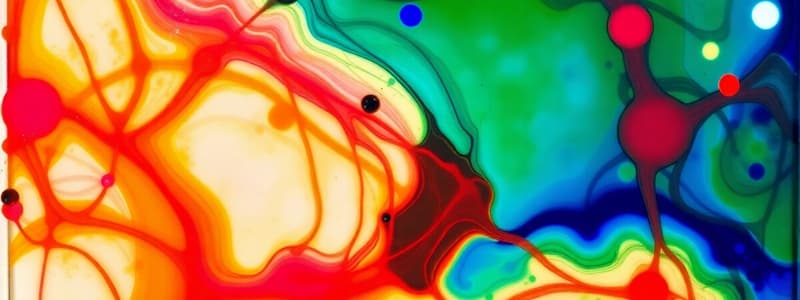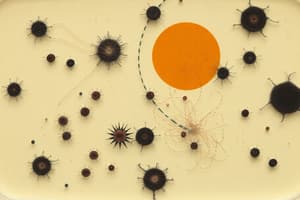Podcast
Questions and Answers
What is the main purpose of isolating a pure culture?
What is the main purpose of isolating a pure culture?
- To increase the diversity of organisms studied
- To accelerate the growth of multiple species
- To examine a single species at a time (correct)
- To mix different species of bacteria
Which of the following is an advantage of the Pour Plate Technique?
Which of the following is an advantage of the Pour Plate Technique?
- Minimizes growth of species that thrive in oxygen
- Easy to isolate individual colonies
- Identifies whether bacteria are anaerobes or aerobes (correct)
- Allows for efficient picking of colonies
What potential issue might arise with the Streak Plate Technique?
What potential issue might arise with the Streak Plate Technique?
- Only anaerobic bacteria can be isolated
- Colonies are difficult to visualize
- Cells may cluster and form indistinguishable colonies (correct)
- Contamination is highly likely
In the context of the Streak Plate Technique, what does the zig-zag pattern help to achieve?
In the context of the Streak Plate Technique, what does the zig-zag pattern help to achieve?
Which is a disadvantage of the Pour Plate Technique?
Which is a disadvantage of the Pour Plate Technique?
How does the Streak Plate Technique differ fundamentally from the Pour Plate Technique?
How does the Streak Plate Technique differ fundamentally from the Pour Plate Technique?
What is an important step in preparing a Streak Plate?
What is an important step in preparing a Streak Plate?
What characteristic of a pure culture allows for the growth of genetically identical cells?
What characteristic of a pure culture allows for the growth of genetically identical cells?
What happens to bacteria in the Pour Plate Technique?
What happens to bacteria in the Pour Plate Technique?
What is the primary goal of using techniques such as the Streak Plate and Pour Plate?
What is the primary goal of using techniques such as the Streak Plate and Pour Plate?
Which technique allows for the examination of bacteria both on the surface and within the depths of the medium?
Which technique allows for the examination of bacteria both on the surface and within the depths of the medium?
What is a major disadvantage of the Streak Plate Technique?
What is a major disadvantage of the Streak Plate Technique?
What type of culture is developed from a single cell or organism?
What type of culture is developed from a single cell or organism?
In which technique are bacteria typically spread in a quadrant pattern over the plate?
In which technique are bacteria typically spread in a quadrant pattern over the plate?
Which of the following best describes a characteristic of an anaerobe?
Which of the following best describes a characteristic of an anaerobe?
What is the primary function of the loop used in the Streak Plate Technique?
What is the primary function of the loop used in the Streak Plate Technique?
Which of the following techniques is most likely to encounter difficulty in removing colonies for further study?
Which of the following techniques is most likely to encounter difficulty in removing colonies for further study?
When performing the Pour Plate Technique, what temperature should the sterilized agar be at before mixing with the specimen?
When performing the Pour Plate Technique, what temperature should the sterilized agar be at before mixing with the specimen?
What is a key step to avoid when using the streaking technique in the Streak Plate Method?
What is a key step to avoid when using the streaking technique in the Streak Plate Method?
Which outcome may result from using too many cells on the inoculating loop during streaking?
Which outcome may result from using too many cells on the inoculating loop during streaking?
What is the main characteristic of a pure culture?
What is the main characteristic of a pure culture?
Which method involves mixing a specimen with liquid agar and then letting it set?
Which method involves mixing a specimen with liquid agar and then letting it set?
What is a significant disadvantage of the Streak Plate Technique?
What is a significant disadvantage of the Streak Plate Technique?
Which scenario best exemplifies a situation where the Pour Plate Technique may not be effective?
Which scenario best exemplifies a situation where the Pour Plate Technique may not be effective?
How are colonies typically arranged using the Streak Plate Technique?
How are colonies typically arranged using the Streak Plate Technique?
What temperature range is typically used to temper sterilized agar for the Pour Plate Technique?
What temperature range is typically used to temper sterilized agar for the Pour Plate Technique?
What is often the primary goal of isolating pure cultures?
What is often the primary goal of isolating pure cultures?
In the context of the Pour Plate Technique, what is a challenge posed by similar appearance among colonies?
In the context of the Pour Plate Technique, what is a challenge posed by similar appearance among colonies?
What is a disadvantage of the Pour Plate Technique regarding the environment of the colonies?
What is a disadvantage of the Pour Plate Technique regarding the environment of the colonies?
What does the zig-zag pattern in the Streak Plate Technique help achieve?
What does the zig-zag pattern in the Streak Plate Technique help achieve?
Flashcards
Streak Plate Technique
Streak Plate Technique
A laboratory technique used to isolate and grow individual bacterial species from a mixed culture. It involves spreading diluted bacterial suspension onto the surface of an agar plate, allowing colonies to grow from individual cells.
Pour Plate Technique
Pour Plate Technique
A technique for isolating bacteria by mixing a solution of bacterial cells with molten agar and pouring it into a petri dish.
Pure Culture
Pure Culture
A population of cells or multicellular organisms growing in the absence of other species or types, originating from a single cell or organism.
Isolation
Isolation
Signup and view all the flashcards
Streak Plate Technique
Streak Plate Technique
Signup and view all the flashcards
Pour Plate Technique
Pour Plate Technique
Signup and view all the flashcards
Facultative Anaerobe
Facultative Anaerobe
Signup and view all the flashcards
Aerobes
Aerobes
Signup and view all the flashcards
Anaerobes
Anaerobes
Signup and view all the flashcards
Streaking Technique
Streaking Technique
Signup and view all the flashcards
Four-Quadrant Streak Procedure
Four-Quadrant Streak Procedure
Signup and view all the flashcards




